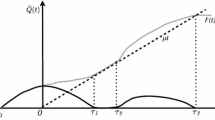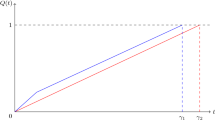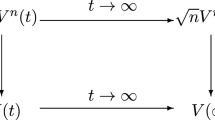Abstract
Consider a single-server queue with a renewal arrival process and generally distributed processing times in which each customer independently reneges if service has not begun within a generally distributed amount of time. We establish that both the workload and queue-length processes in this system can be approximated by a regulated Ornstein-Uhlenbeck (ROU) process when the arrival rate is close to the processing rate and reneging times are large. We further show that a ROU process also approximates the queue-length process, under the same parameter assumptions, in a balking model. Our balking model assumes the queue-length is observable to arriving customers, and that each customer balks if his or her conditional expected waiting time is too large.
Similar content being viewed by others
References
: 2000, Extend: Professional simulation Tools. Imagine That, 6830 Via Del Oro, Suite 230, San Jose, CA 95119, version 5 edition.
: 2002, Cisco: Behind the hype. Business Week.
C.J. Ancker and A.V. Gafarian, Queueing with impatient customers who leaveat random, Journal of Industrial Engineering 13 (1962) 84–90.
F. Baccelli, P. Boyer and G. Hebuterne, Single-server queues with impatient customers, Adv. Appl. Prob. 16 (1984) 887–905.
L. Brown, N. Gans, A. Mandelbaum, A. Sakov, H. Shen, S. Zeltyn and L. Zhao, Statistical analysis of a Telephone Call Center: A queueing-science perspective, Working Paper, (2002).
S. Browne and W. Whitt, Piecewise-linear diffusion processes, in: Advances in Queueing: Theory, Methods, and Open Problems, ed. J. Dshalalow (CRC Press, 1995) pp. 463–480.
H. Chen, Generalized regulated Mapping: Fluid and diffusion limits, Notes prepared for Avi Mandelbaum, 1990.
H. Chen, and D.D. Yao, Fundamentals of Queueing Networks: Performance, Asymptotics, and Optimization (Springer-Verlag, New York, 2001).
E. Coffman, A. Puhalskii, M. Reiman and P. Wright, Processor-shared buffers with reneging, Performance Evaluation 19 (1994) 25–46.
B. Doytchinov, J. Lehoczky and S. Shreve, real-time queues in heavy traffic with earliest-deadline-first queue discipline, Annals of Applied Probability 11 (2001) 332–378.
D. Gamarnik and A. Zeevi, Validity of heavy traffic steady-state approximations in open queueing networks, Working Paper, 2004.
O. Garnett, A. Mandelbaum and M. Reiman, Designing a call center with impatient customers, Manufacturing and Service Operations Management 4 (2002) 208–227.
P. Hall and C.C. Heyde, Martingale Limit Theory and its Application (Academic Press, Inc., Boston, 1980).
J.M. Harrison, Brownian Motion and Stochastic Flow Systems (John Wiley & Sons, New York, 1985).
D.L. Iglehart and W. Whitt, Multiple channel queues in heavy traffic, I and II, Adv. Appl. Prob. 2 (1970) 150–177 and 355–364.
R. Lillo and M. Martin, Stability in queues with impatient customers, Stochastic Models 17 (2001).
A. Mandelbaum and S. Zeltyn, The impact of customers’ patience on delay and abandonment: Some empirically-driven experiments with the M/M/N + G queue, OR Spectrum 26(3) (2004) 377–411. Special Issue on Call Centers.
C. Palm, Etude des delais d’attente, Ericson Technics 5 (1937) 37–56.
E.L. Plambeck, S. Kumar and J.M. Harrison, A multiclass queue in heavy traffic with throughput time constraints: Asymptotically optimal dynamic controls, Queueing Systems 39 (2001) 23–54.
J. Reed and A.R. Ward, A diffusion approximation for a generalized Jackson network with reneging, in: Proceedings of the 42nd Annual Allerton Conference on Communication, Control, and Computing, 2004.
M.I. Reiman, Some diffusion approximations with state space collapse, in: Lecture Notes in Control and Information Sciences, eds. F. Baccelli and G. Fayolle (Springer, 1984) vol. 60 pp. 209–240.
R.E. Stanford, Reneging phenomena in single channel queues, Mathematics of Operations Research 4 (1979) 162–178.
A.R. Ward and P.W. Glynn, A diffusion approximation for a Markovian queue with reneging, Queueing Systems 43 (2003a) 103–128.
A.R. Ward and P.W. Glynn, Properties of the reflected ornstein-uhlenbeck process, Queueing Systems 44 (2003b) 109–123.
W. Whitt, Improving service by informing customers about anticipated delays, Management Science 45(2) (1999) 192–207.
Author information
Authors and Affiliations
Corresponding author
Rights and permissions
About this article
Cite this article
Ward, A.R., Glynn, P.W. A Diffusion Approximation for a GI/GI/1 Queue with Balking or Reneging. Queueing Syst 50, 371–400 (2005). https://doi.org/10.1007/s11134-005-3282-3
Received:
Revised:
Issue Date:
DOI: https://doi.org/10.1007/s11134-005-3282-3




